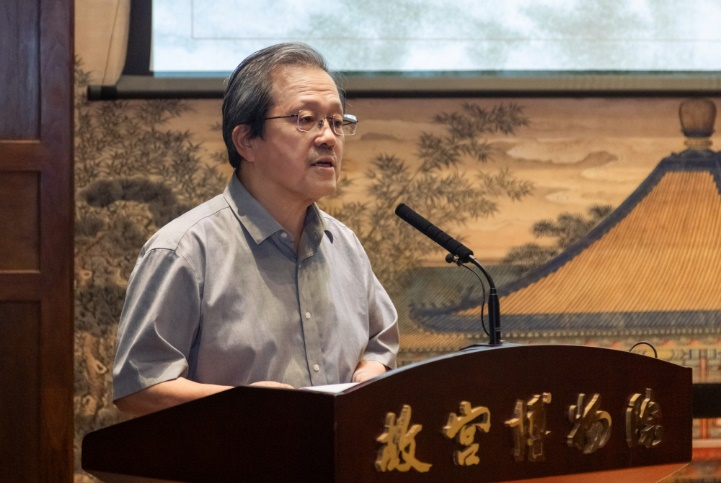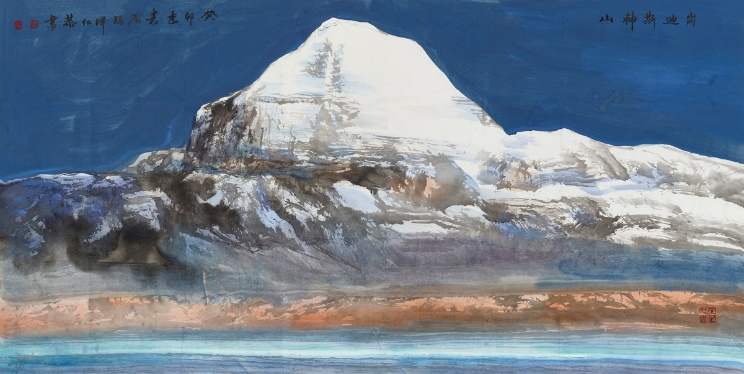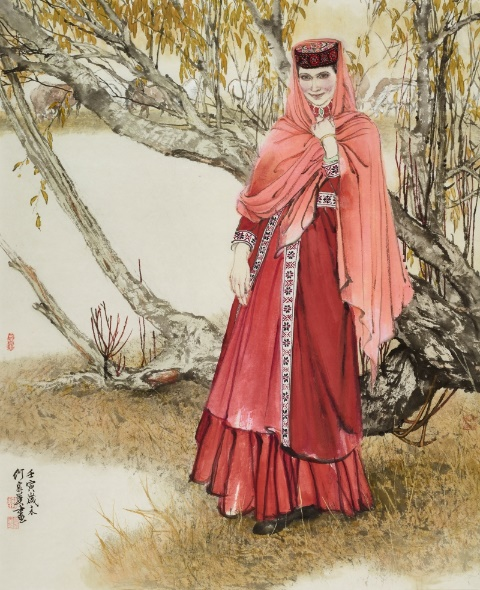Exhibition on calligraphy and painting by CCICH researchers opens at Palace Museum
On July 3, the Palace Museum’s Gate of Divine Prowess (Shenwu men) became the venue for an exhibition showcasing calligraphy and painting works by researchers from the China Central Institute for Culture and History (CCICH). This exhibition is a collaborative effort between the Counselors’ Office of the State Council, the CCICH, and the Palace Museum.
The opening ceremony welcomed approximately 100 distinguished guests, including Feng Yuan, vice president of the CCICH; Wang Xudong, member of the Party leadership group of the Ministry of Culture and Tourism and director of the Palace Museum; Zhang Yantong, member of the Party leadership group and deputy director of the State Council Counselors’ Office; Du Haijiang, Party secretary and deputy director of the Palace Museum; and Wang Yuegong, deputy director of the Palace Museum. Also present were CCICH researchers Jin Hongjun, Ma Zhensheng, Guo Yicong, Wu Jingshan, Li Yan, Nyima Tsering, Cheng Dali, and Fan Di’an. Other distinguished participants included Li Xin, CPC branch group secretary and vice chairman of the China Calligraphers Association; Zheng Peiliang, deputy director of the Calligraphy Art Center of the China Federation of Literary and Art Circles; Zhao Dong, Party secretary and executive director of Rong Bao Zhai; officials and executives from the State Council Counselors’ Office, the CCICH, and the Palace Museum; as well as representatives from academia, art, and the media.
The opening ceremony was chaired by Yang Zhixin, director of the CCICH Research Center of the State Council Counselors’ Office. Feng Yuan and Du Haijiang delivered speeches, and Fan Di’an spoke on behalf of the CCICH researchers. Zhang Yantong, representing the State Council Counselors’ Office and CCICH, presented the Palace Museum with some publications, including a special edition of Chinese Calligraphers and Painters on calligraphy and painting works by CCICH researchers and Sing Out Loud.

Feng Yuan, vice president of China Central Institute for Culture and History, delivers a speech in Beijing on June 3, 2023.
In his speech, Feng Yuan emphasized the significance of the exhibition as a crucial step in implementing the guiding principles of the 20th CPC National Congress and General Secretary Xi Jinping’s key speeches. Feng highlighted that General Secretary Xi Jinping’s recent speech at the symposium on cultural inheritance and development elucidated critical theoretical and practical issues related to Chinese cultural heritage and development. Feng further noted the important role of CCICH researchers in promoting Chinese modernization, preserving China’s fine traditional culture, contributing to cultural strength, and advancing the modern civilization of the Chinese nation.
Since the 18th CPC National Congress, CCICH researchers have made significant progress in harnessing the power of traditional culture, strengthening national cultural identity, promoting cultural and art creation, and steering new trends of our times. Under the new situation, CCICH will intensify efforts around the theme of “building the modern civilization of the Chinese nation.” By leveraging its advantages, CCICH will remain committed to the principle of “respecting culture and learning from history” and take on new cultural missions, according to Feng. Feng expressed his confidence that CCICH would continue to conduct in-depth studies and make significant new discoveries in the field of cultural and historical research.

Du Haijiang, Party secretary and deputy director of the Palace Museum, delivers a speech in Beijing on June 3, 2023.
Du Haijiang, in his speech, underscored the historical responsibility of Chinese Communists to adapt Marxism to the Chinese context and the needs of the times. The exhibition exemplified the Palace Museum’s efforts to implement General Secretary Xi Jinping’s requirement of adapting basic tenets of Marxism to China’s realities and traditional culture. This is of great significance to strengthening the foundation of the Chinese path, creating new opportunities for innovation, upholding cultural identity and building a modern Chinese civilization. Du emphasized the Palace Museum’s commitment to connecting the past and present, focusing on inheritance and innovation, and engaging in extensive cooperation with various sectors of society to preserve and develop excellent traditional culture. Following the principle of “pursuing shared development and mutual benefit, drawing on each other’s strengths, and sharing resources,” the Palace Museum will seek cooperation in areas such as heritage protection, exhibition and public education, Du said.

The Gangdise Mountains by Nyima Tsering (68x138cm) 2023

A piece of calligraphy work by Shen Peng (136×68cm) 2023

A love song of Pasture by He Jiaying (75×62cm) 2023
The exhibition showcased calligraphy and painting works created by 20 esteemed CCICH researchers. In addition, it featured over 100 documents, including manuscripts of creative works, academic papers, prose essays, sketches, albums, and anthologies. The calligraphy and painting works are characterized by their distinctive themes, rich meanings, and diverse forms of expression. The handwriting and manuscripts reflect the artists’ insights and humanistic values. These exhibits demonstrate the collective achievements and personal styles of CCICH calligraphers and painters.
A seminar on calligraphy and painting works by CCICH researchers was also held on the same day. It was presided over by Shang Hui, director of China Artists Association Art Theory Committee, and Zhang Gongzhe vice president and deputy editor-in-chief of the Chinese Calligraphers and Painters magazine. Liu Xilin, a researcher at the National Art Museum of China and former vice director of China Artists Association Art Theory Committee, presented an academic summary. A number of experts and scholars spoke at the seminar, including Wang Yong, a researcher at the Chinese National Academy of Arts, Zheng Xiaohua, a professor at Renmin University of China who is also former secretary of the CPC branch group and secretary-general of China Calligraphers Association, Ma Xinlin, former deputy director of the Department of Calligraphy and Painting of CCICH and a CCICH researcher, and Han Shaoxuan, a postdoc at the National Museum of China. They delivered speeches on the essence of Chinese calligraphy and painting art and principles of art creation. Their discussion also shed light on the artistic styles of CCICH calligraphers and painters, as well as the inheritance and innovation of their techniques. They shared ideas and insights on the development of Chinese calligraphy and painting art in the new era.



